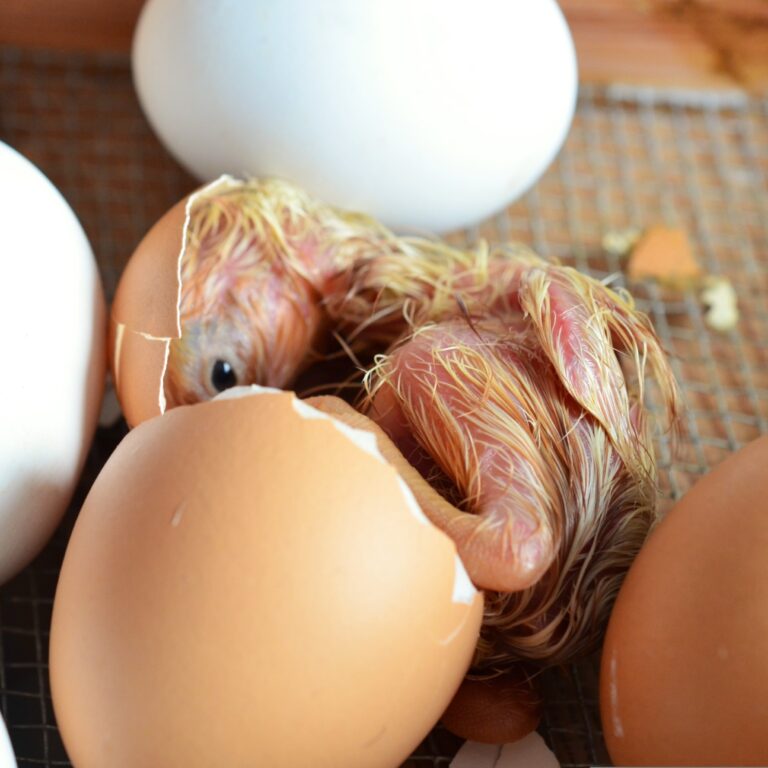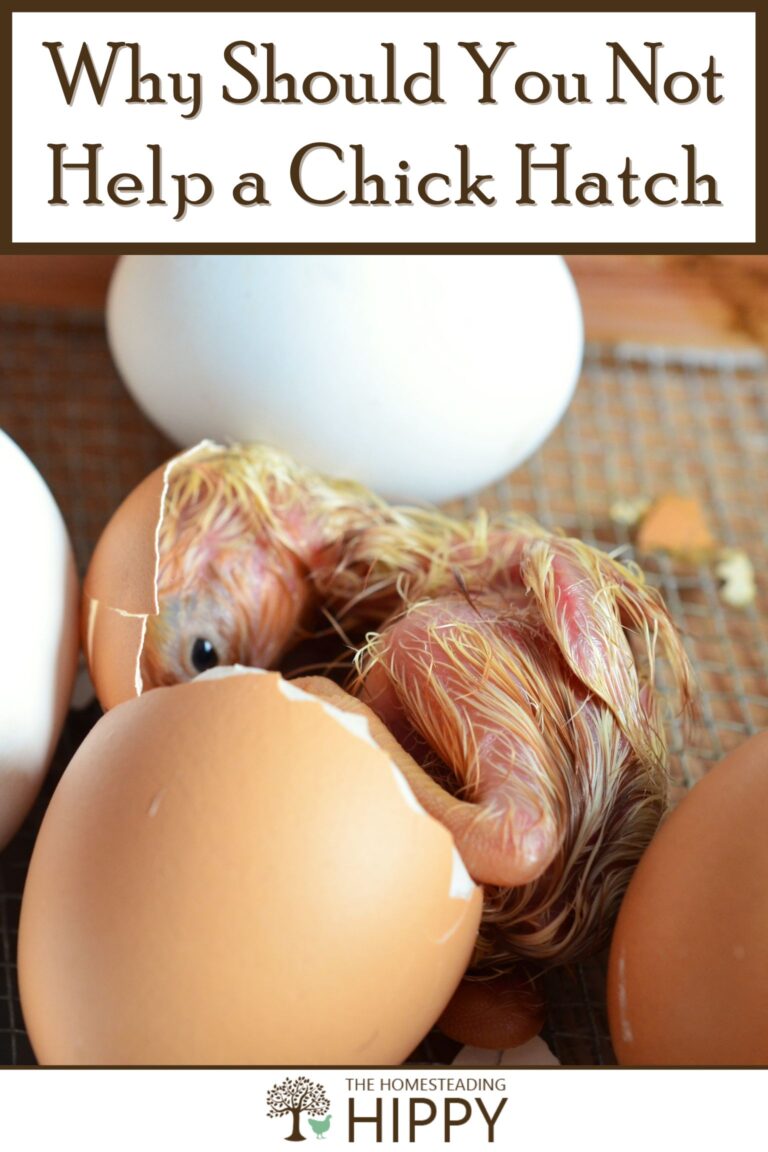It’s a heartwarming scene: a baby chick, all alone in the world, pits its tiny body against the unyielding shell that protected it but that now stands between it and life on the outside.

The little creature gives it all it has, using its tiny legs and beak to slowly chip away at the barrier.
As you watch, you can’t help but feel a stirring of compassion. Surely this poor thing could use a helping hand, you think to yourself. But should you? Why shouldn’t you help a baby chick hatch?
In most cases, you should never help a chick hatch. Healthy chicks are born with a tiny egg tooth and strength enough to break free of the shell. Helping a healthy chick might cause various health problems.
In most cases, the urge to help most folks feel is understandable, but misguided and may cause harm. At worst, they could be derailing nature that would inevitably take its course in the wild.
But when it comes to raising animals and especially chickens there is no such thing as “never.” Keep reading and we’ll tell you more about why you should, generally, not help a chick to hatch.
1. You Are Probably Jumping the Gun.
A healthy chick can pip, and then there may be no noticeable movement or activity for up to 24 hours prior to zipping and emergence.
Most inexperienced owners who are raising eggs in incubators tend to get anxious during this time and intervene, causing more harm than good because they don’t know what to expect.
There is no reason to panic whatsoever once the chick has pipped until the 24 hour mark has passed. Steady on!
2. The Shell Is Crucial to the Chick’s Development Right to the End.
As the chick develops inside the egg, the shell serves several important functions. It protects the developing embryo and provides a consistent temperature and humidity level.
The shell also slowly absorbs calcium from the surrounding environment, which gets deposited in the eggshell and helps to form the chicks’ bones and beaks.
Chicks that are helped out of their shells miss out on this crucial absorption period and can end up with deformities, weaker bones, and softer beaks.
3. The Yolk Sac Is Essential for Nutrition.
While in the egg, the chick lives off of a yolk sac that is attached to its belly. This sac contains all of the nutrients that the growing chick needs.
When the hatching process is very near, the chick will actually take a rest and absorb the remainder of the yolk into its body. This is vital for the energy and development of the chick.
If you help a chick hatch, there is a good chance that you will tear or disrupt the yolk sac in the process.
This can be fatal for the chick, as it will no longer have a source of food and hydration and even if it does survive its development will be stunted.
4. You Might Injure the Chick.
When you help a chick hatch, you run the risk of injuring it. The hatching process is slow for a reason- it gives the chick time to absorb nutrients from within the shell and fully develop its skeleton.
If you try to speed up the process by breaking open the shell, you could easily fracture one of the chicks’ fragile bones.
The umbilical cord is also very vulnerable at this stage. This cord provides vital nutrients and hydration to the chick and if it is damaged or ruptured, the chick will not be able to survive.
5. Opening the Incubator Early Will Cause Major Issues.
If you are keeping viable eggs in an incubator, it is important to maintain a consistent temperature and humidity level.
If you open the incubator door too early, you can disrupt this delicate balance and cause the eggs to cool off too quickly or dry out. This will kill the developing chicks inside and put your entire clutch at risk.
6. You Might Introduce Disease.
When you help a chick hatch, you are also introducing outside bacteria into the egg. This can be dangerous for the chick, as its immune system is not yet developed enough to fight off infection.
Chicks are covered in fluids which helps to keep them sterile while they are inside the egg. Once this coating is removed, the chick is vulnerable to diseases.
If you have been handling other animals or even just touched something dirty, you could inadvertently transmit a deadly disease to the vulnerable chick.
7. It’s Best to Let Nature Take Its Course.
As much as you might want to help a chick hatch, it is generally best to let nature take its course.
Healthy chicks will hatch on their own, while chicks that are sick, too weak, deformed or otherwise impaired will die, keeping the genetics of the flock and the species stronger.
Now, most owners have strong opinions about this, and that is fine, but if you don’t want a special needs chicken down the road you might not want to save chicks struggling to hatch.
There are times when you may need to help a healthy chick hatch.
Like I mentioned above, never say never when it comes to chickens. There are in fact occasions when helping a viable chick hatch might be necessary, and both usually result from human error. We’ll tell you about them in the next sections.
8. You Should Help a “Shrink Wrapped” Chick.
“Shrink wrapping” is a condition that can happen to chicks in the incubator (or even after they’ve pipped) and it’s caused by the loss of too much moisture.
Chicks need to lose a certain amount of moisture as they develop in order to hatch, but if they lose too much they can become “wrapped” in the membrane inside the shell, which will dry and cling to them, preventing them from moving.
The good news is that this is usually an easy fix if the chick otherwise developed normally.
All you need to do is carefully rehydrate the membrane with a little warm, distilled water and then gently peel or massage it away from the chick.
The bad news is that this can happen easily when the humidity in the incubator is too low, so be sure to keep an eye on it!
9. You Should Help a Sticky Chick.
Another common problem is when a chick becomes “sticky”. This can happen for a number of reasons, but the most common is that the humidity in the incubator drops when the chick was ready to hatch.
When this happens, the fluids in the egg harden and dry around the chick, cementing it in place or greatly hindering its movement.
If you can detect peeping or activity in the egg, especially after a weak pip, your chick might be stuck and could use a hand.
Again, the best thing to do is use a little warm water and then gently massage the affected areas until the chick is clear. Be sure not to break any bones in the process!
10. You May Need to Help a Pipped Chick That Isn’t Zipping After 24 Hours.
A “zip” is when the chick makes a bigger hole in the shell after pipping to start pushing its way out. This can take a while, sometimes up to 24 hours, so it’s important to be patient.
However, if 24 hours have passed and there is no sign of progress, but the chick sounds vital inside the shell, you may need to give the chick a little help.
This might result in no defect in the chick, but an abnormality with the egg itself. Sometimes, a hard patch or increased overall thickness might unduly burden a little chick until it loses strength and gives up.
Now, this can be very difficult to discern compared to legitimate problems with the chick, so you’ll need to make the call. If you do decide to help, do so very carefully. You don’t want to damage the chick and cause even more problems!

Tom has built and remodeled homes, generated his own electricity, grown his own food and more, all in quest of remaining as independent of society as possible. Now he shares his experiences and hard-earned lessons with readers around the country.
Find out more about the team here.
